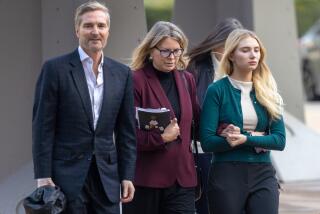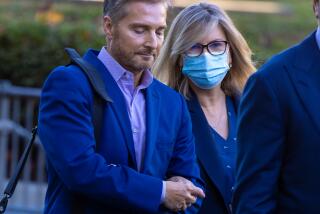Building a New Life on Ruins of the Old
- Share via
Claudia Osborn has had two lives. In the first, she was a successful internist, director of residency training at two Detroit hospitals and a professor of medicine at Michigan State University’s College of Osteopathic Medicine.
That life ended abruptly in July 1988, when a motorist slammed into Osborn’s bicycle, causing irreversible brain damage to the 33-year-old physician.
Osborn’s subsequent quest was to rebuild herself and her career. It continues to this day.
But she mourns her earlier self. “I certainly feel a tremendous sense of loss of that former life, because I remember that life,” Osborn said.
On that summer evening in 1988, Osborn and her best friend and housemate, fellow internist Marcia Baker, had gone for a bike ride. Osborn wasn’t wearing a helmet. Just blocks from her Grosse Pointe, Mich., home, an old Chevy took a too-wide turn and came barreling at them.
Baker was able to throw herself over the curb and onto a grassy bank to escape, but Osborn wasn’t as lucky. The Chevy’s grille slammed into her bicycle, hurtling her into the air. She landed on her head, instantly falling unconscious. Her body assumed a rigid “decorticate” position--arms clenched at chest--which is a sign of serious brain injury.
Osborn regained consciousness a short time later at a hospital, prompting her doctors and loved ones to hope that all she had suffered was a concussion, a sprained shoulder and abrasions.
But for the first two weeks after the accident, Osborn slept 22 hours daily. When she was able to stay awake for prolonged periods, she found she had little control of her right side. She was unable to follow conversations, read her mail or do simple arithmetic. And she would often forget where she was going.
Convincing herself that these were transitory problems, Osborn returned to work.
But she struggled to read medical literature; the sentences seemed incomprehensible. Only when she forgot to review a patient’s X-ray--which could have jeopardized the patient’s life--did Osborn acknowledge that she might be in serious trouble.
She phoned Rhonna Shatz, a neurologist and colleague at Henry Ford Hospital in Detroit. “Do not practice medicine again until I examine you,” Shatz said.
Osborn agreed. “I didn’t protest. It isn’t hard to walk away from something you love if you think you are coming right back,” she wrote much later.
But tests soon revealed that Osborn’s frontal and parietal lobes, which affect intellect, memory and judgment, had been damaged. As weeks wore on, the extent of Osborn’s injuries became evident.
Her personality had markedly changed. Once dynamic and animated, Osborn now was lethargic; she spoke in a dull monotone. She struggled with “flooding”-- being overwhelmed by stimuli and shutting down mentally. Some mornings, she would put on her shoes, then step into the shower. Or she would stop at the post office and mail her car keys.
Baker was thrust into the role of caretaker for Osborn. And Osborn’s mother, Jeanne Findlater, a television station manager, took an early retirement to help her daughter.
“I put menus on the refrigerator door, signs on the front door, saying, ‘Did you comb your hair?’ ” Findlater said. “I went from disbelief that something was wrong to panic and fear, and then, finally, to education.”
Findlater and Baker realized that only with persistent care and intensive rehabilitation efforts could Osborn have a chance at recovery. They pledged to see her through.
“I started then becoming positive that all three of us could make a difference,” Findlater said.
In 1989, Osborn enrolled in the nationally known Head Trauma Program at the Rusk Institute of Rehabilitation at New York University Medical Center in Manhattan. She hoped that, after a few months there, she could return to her medical practice.
Unfortunately, five months into the program, she was forced to concede that this would not be possible. She battled waves of depression.
“She really did not have a clue as to the extent of her thinking problems as a result of the brain injury,” said Joan Gold, a therapist at Rusk. “She had expected to be with us for about six months and return to a full practice of medicine. She lacked animation; she didn’t have an ability to access her intellect or to generate ideas. Her ability to express herself was diminished. But that’s a very different woman today.”
Eighteen months later, she returned to Detroit, armed with a litany of coping strategies and memory props to assist her in regaining at least some of her former independence. She still uses most of them. She writes notes itemizing the steps for getting dressed. She sets up cue cards reminding her to perform simple tasks like brushing her teeth.
“She was able and willing to allow herself to hear and understand, no matter how it hurt, what she needed to do,” Gold said. “This was a woman who was willing to grab onto any kind of system or strategy to enable her to access her intellect and creativity and be something in this world.
“That’s what makes her very special. Not many people who suffer a brain injury are able to do what she did. She really is a ray of hope, an inspiration for anyone who’s suffered a brain injury.”
Osborn said, “The most strain was returning home after rehab. I think our expectations and our hope was that rehab was going to do more than rehab was capable of doing. Re-acclimating to my home environment was very challenging.”
Findlater, who initially stayed with Osborn every other month and consulted with her “four to 10 times a day” by phone, classified her daughter’s outfits “A,” “B” and “C,” so she could mix and match.
Osborn set up her computer to serve as her “peripheral brain,” helping her to extend her concentration. When people call, she consults her “acquaintance databank” to help her remember who the person is, when they last interacted and additional personal details.
She uses two beepers and a digital recording device to remind her about important tasks. And a service dog, Mica, an 8-pound sheltie, escorts her on bus trips, helps her board planes at the right time and reminds her to take her medication each night.
Perhaps the best development for Osborn has been the progressive return of her language abilities. In 1990, she began keeping a journal of her experiences. Eventually, she realized that, in book form, the writings could help others better understand her challenges. It took seven years to complete her book, “Over My Head: A Doctor’s Own Story of Head Injury From the Inside Looking Out” (Andrews McMeel Publishing, 1998).
Today, with Findlater’s and Baker’s help, Osborn is living a full life. She lectures nationally about traumatic brain injury rehabilitation. She cycles (wearing a helmet), goes in-line skating, kayaks and rides horseback. At Henry Ford Hospital, she conducts patient neurological testing and record chartings, with the aid of a medical assistant. She also teaches first-year medical students about history-taking and physical exams at Michigan State.
Osborn acknowledged that, at times, she misses her former life. “I would love to be that woman again, but she died in 1988,” she wrote in “Over My Head.”
“She’s a remarkable fighter,” Baker said. “She is a person who defines the concept of being able to change adversity into opportunity.”
Osborn said she has also begun a second book on traumatic brain injury. This one will focus on coping strategies for injured individuals and their loved ones. “It will cover issues about moving on with your life,” she said.
With the injury have come some gifts, too. Osborn has a heightened perception of colors, which has propelled her to take up painting. She finds that she writes more poetically, and she is more excited by stimuli.
“I have a childlike glee that’s hard to rein in, which probably isn’t a bad thing,” Osborn said. “In some ways, it’s a heightened appreciation of the little things.”
The 20-year-old motorist who injured Osborn pleaded not guilty to careless driving, but was convicted and fined $100. His insurance company refused to compensate Osborn, so she sued and won a $20,000 settlement. She also filed a civil suit against the man and was awarded an $8,000 judgment.
Osborn likens the path she has taken since her injury to a long, winding detour. When a bridge washes out, she said, one must find an alternative route to one’s destination. She looks forward to continuing her lecturing, helping others with similar injuries and making new acquaintances.
“Most of my friends from before the injury I retained,” Osborn said. “But I’m pleased that I’ve developed some new friendships since the injury. You never see in their eyes the disappointment that you’re not the way you were before.”
She’s grateful to her mother and Baker, who has remained her best friend and housemate for 17 years, for being the driving forces behind her recovery. Without them, her great progress wouldn’t have been possible, Osborn said.
Though some people have told Osborn that she must forget her old career to move forward, she hasn’t abandoned hope of one day practicing internal medicine again, or perhaps getting into a new specialty, such as end-of-life care.
“You need to aspire to the impossible if you’re going to achieve as much as possible,” Osborn said. “I still hold a dream of returning to medicine. I don’t think that’s impossible. If I’m working very hard at [finding ways] how to learn, how to retrieve information, then it is certainly possible. Someday.”
(BEGIN TEXT OF INFOBOX / INFOGRAPHIC)
Moving on After an Injury
In 1988, Dr. Claudia Osborn was struck by a motorist as she cycled near her home. She sustained a serious brain injury that impaired her memory, shortened her attention span and caused her to have difficulty performing even basic everyday tasks. She had to give up her medical practice. But 12 years later, after intensive rehabilitation and perseverance, she teaches medical students part time and lectures on traumatic brain injury. She offers five tips for people who face similar challenges.
1. Enlist support. You need good coaches who will assist you with what you can’t do, teach you new strategies and foster your independence.
2. Practice, practice, practice. A good rehabilitation program is important. Daily personal effort is essential.
3. Take small steps forward. It’s great to have far-reaching goals, but focus on what you can achieve today.
4. Measure yourself against yourself. Compare your progress in relation to last month, not in relation to your pre- injury/illness abilities.
5. Look forward and create new dreams rather than looking back. We all want the magic potion that will restore our old life. People who can’t have their old life back and are unwilling to move forward into a new life are disabled by their grief. Life is different now, but it can be just as rewarding and happy.
More to Read
Sign up for Essential California
The most important California stories and recommendations in your inbox every morning.
You may occasionally receive promotional content from the Los Angeles Times.













